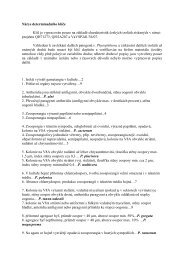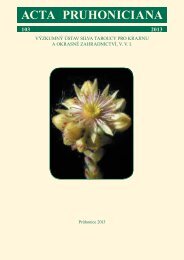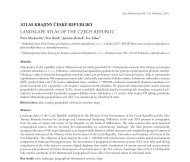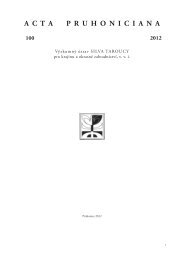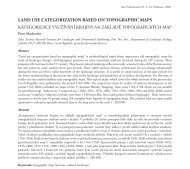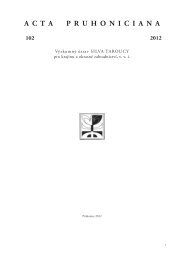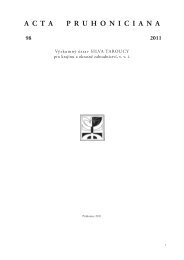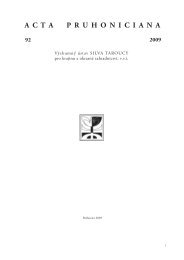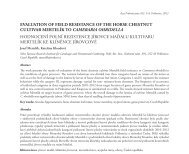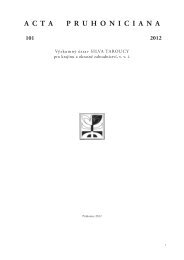in Eastern Slovakia, on the border with Ukraine. Thecorresponding managed populations occur at a 500–1000 mdistance from the primeval stands in Badín and Dobroč and/or at a 2 km distance from the primeval population in Stužica.In case of Stužica primeval stand, an additional managedpopulation has also been used occurring at a 40 km distancein Palota. Based on the available records, all the managedpopulations are of natural not artificial origin. Both adulttrees and regenerants were subjected to the analysis. Theregenerants involved seedlings and saplings from naturalregeneration with estimated age of 3–10 years. Their numberis given in the tables illustrating experimental data.The twigs with young needles were collected from randomlyselected trees and regenerants early in summer 2006, whereasthose with dormant buds during the late autumn and inwinter of the same year. Collected material was stored at– 80 °C until its <strong>pro</strong>cessing. In principle, the same sets ofadult trees were used for DNA and isoenzyme analyses withindividual trees differing only in their numeration. The extentof overlapping at the seedling level was much lower. Thesame populations but different individuals have as a rule beenused in this case. Owing to much more variable nature of theisozymes than cpDNA, the number of trees used in isozymeanalysis was nearly doubled compared to cpDNA analysis.DNA analysisTotal DNA was extracted from young needles of individualtrees and regenerants using Murray and Thompson (1980)<strong>pro</strong>cedure. Non-coding region of chloroplast DNA (cpDNA)between the genes trnS-psbC was amplified with the universalprimer as <strong>pro</strong>posed by Demesure et al.(1995). PCR <strong>pro</strong>ductswere digested by Hae III restriction enzyme followed byelectrophoretic separation of generated fragments in 7 %polyacrylamide gels.Isoenzyme analysisBuds with removed scales were homogenized with pestle inwells on a plate using 100 mM TRIS-HCl buffer pH 7.3 withpolyvinylpyrollidone (PVP) 40, PVP 80, EDTA II, Tween,polyethylene glycol, 2-mercapto-ethanol and dithiothreitoladded. Enzyme separation was performed electrophoreticallyin 12 % (w/v) starch using lithium-borate-Tris-citrate, pH8.1 and Tris-histidine-Tris-citrate, pH 7.0 buffer systems.The former was applied in assaying the enzyme systems ofleucine aminopeptidase (LAP-E.C.3.4.11.1), glutamate-oxalatetransaminase (GOT-E.C.2.6.1.1), glutamate dehydrogenase(GDH-E.C.1.4.1.3) and fluorescent esterase (F EST-E.C.3.1.1.1),the latter in assaying of 6-phosphogluconate dehydrogenase(6PGD-E.C.1.1.1.44), shikimic acid dehydrogenase (ShDH-E.C.1.1.1.25), malate dehydrogenase (MDH-E.C.1.1.1.37),phosphoglucose isomerase (PGI-E.C.5.3.1.9) and isocitratedehydrogenase (IDH-E.C.1.1.1.42). Isoenzyme visualizationin gels was performed according to the user’ s manual byPitel and Cheliak (1984), zymogram interpretations followedthe recommendation of Hussendörfer et al. (1995). Allelicfrequencies at each locus were calculated based on diploidgenotypes. Genetic diversity was characterized in termsof the mean number of observed alleles per locus, effectivenumber of alleles and expected heterozygosity. The enzyme70system represented in sampled trees by the same numberof its isoenzymes with identical mobility was classified asmonomorphic as compared with the polymorphic enzymesystems exhibiting in individual trees either different numberof isoenzymes or the same number of isoenzymes with differentmobilities. Banding patterns varying in this respect were takenfor allelic variants. A locus containing the same allelic variantsin sampled trees is regarded to be monomorphic, whereasthe locus with different allelic variants in individual trees isclassified as polymorphic (Silvertown, Charlesworth, 2005).Genetic differentiation between individual populations wasquantified using genetic distances according to Nei (1978).Some characteristics of the allelic variability and geneticdistances were calculated using PopGene <strong>pro</strong>gramme (Yeh etal., 1997).RESULTSThe flanking segment between the genes trnS-psbC is the onlyregion of cpDNA exhibiting individual variation in silver fir(Ziegenhagen et al., 1995). Digestion of PCR <strong>pro</strong>duct ofthe region by Hae III generates two distinct haplotypes. Thehaplotype A is characterized by 3 fragments of 700, 470 and120 bp size, whereas the restriction <strong>pro</strong>file of haplotype Binvolves 4 restriction fragments of 700, 300, 170 and 120 bpsize (Fig. 1).Fig. 1. Restriction <strong>pro</strong>files of haplotypes A and B in silver fir(Reštrikčné <strong>pro</strong>fily haplotypov A a B u jedle bielej)Their distribution among individual populations is summarizedin Table 1. Of the 14 populations analyzed, the haplotypeA prevailed in 11 of them. The most striking difference in<strong>pro</strong>portion of these haplotypes was observed between adulttrees of the primeval populations in Badín and Dobroč onthe one hand, and those of Stužica primeval populationon the other hand, sharing the reversed <strong>pro</strong>portions ofhaplotypes. Less conspicuous were the differences inhaplotype <strong>pro</strong>portions of adult trees of all the three primeval
populations and their managed counterparts. A slightlyincreased frequency occurrence of haplotype A has as a rulebeen observed in managed populations. The populationson the localities Badín and Dobroč have also deviated fromthose in Stužica in haplotype A <strong>pro</strong>portions detected in adulttrees and in their regenerated <strong>pro</strong>genies. The populations ofthe former share a lower <strong>pro</strong>portion of the haplotype A inregenerants than in adult trees, whereas the figure in Stužicais opposite. However, the variable as it seems, the chi-quadrattest has not confirmed statistical significance in the haplotypeA/B <strong>pro</strong>portions between neither individual primeval standsanalyzed nor between the primeval populations and theirmanaged counterparts. The absence of these differences refersto both adult trees and regenerants.Based on allelic frequency distribution of the 14 enzyme geneloci, the basic parameters of genetic diversity were calculatedfor the primeval and managed populations of silver fir. The<strong>pro</strong>portion of polymorphic loci varied considerably amongthe populations ranging between 0.5 and 0.92 (Table 2). Threeloci (LAP-B, IDH, F EST) were found to be polymorphiccompletely as contrasted with a monomorphic nature of theShDH-A in all the populations surveyed. The remaining lociexhibited a variable degree of polymorphism contributingmore or less to differentiation of individual populations. Ofthese, the six loci (LAP-A, 6PGD-A, 6PGD-B, ShDH-B,MDH, PGI-B) are highly polymorphic in all the populationsanalyzed, whereas the four loci (GOT-A, GOT-B, PGI-A,GDH) are prevailingly monomorphic. The populations onthe localities Badín and Stužica share similar <strong>pro</strong>portions ofpolymorphic loci (0.78–0.92 and 0.64–0.92) with number ofobserved alleles 1.92–2.42. Possessing reduced <strong>pro</strong>portion ofpolymorphic loci (0.5–0.78) and lower number of observedalleles (1.57–2.00), the populations in Dobroč deviate fromthe populations mentioned above. The same tendency isalso characteristic for the effective number of alleles whichrefers to the measure of genetic diversity. The populations inBadín and Stužica were comparable in this respect possessing1.39–1.47 and 1.36–1.55 effective alleles, respectively, but thefigure in Dobroč was lowered little. The calculated numberof effective alleles of the latter ranged within the limit of1.27–1.38 only. Th data presented above refer to the regionaldifferences of silver fir populations involving both adult treesand regenerants of the primeval and managed stands of thespecies on the respective localities in Middle and EasternSlovakia.As far as the differences between primeval and managedpopulations are concerned, the figure is rather variable. Atthe level of adult individuals, the <strong>pro</strong>portion of polymorphicloci was found to be the same in Badín (0.78) but reducedin Dobroč and Stužica primeval populations (0.57 vs 0.78in managed stand; 0.64 vs 0.71 in managed stand). Fromthe standpoint of relationship between adult trees andregenerants, an increased <strong>pro</strong>portion of polymorphic lociprevailed in regenerants of the individual stands except forthe primeval and managed populations in Stužica where thereversed relationship was observed. Dobroč populations wereexceptional also with respect to the number of observed allelespossessing higher number of alleles in mature individuals thanin regenerants of both primeval and managed populations.An opposite figure was found to be valid for Badín andStužica stands with a higher number of observed alleles inregenerants (Table 2). To some degree analogous situationwas also characteristic for the number of effective alleles.The discrepancy concerned only the primeval populations inBadín and Stužica and/or managed stands Palota with highernumber of effective alleles in adult trees.The expected heterozygosity as principal components ofthe genetic diversity has reached a higher level in primevalTable 1. Chloroplast DNA haplotype <strong>pro</strong>portions in three primeval populations of silver fir and intheir corresponding managed counterparts as revealed at the adult individuals level and in regenerants(Pomer haplotypov chloroplastovej DNA pri troch populáciach jedle bielej v pralesoch a u priľahlýchobhospodarovaných porastoch jedle zistený na úrovni dospelých jedincov a regenerantov)PopulationsNumber ofcpDNA haplotypesindvidualsABBadin – primeval stand, adult trees 28 16 (57.1 %) 12 (42.8 %)Badin – primeval stand, regenerants 67 35 (52.2 %) 32 (47.8 %)Badin – managed stand, adult trees 30 19 (63.3 %) 11 (36.7 %)Badin – managed stand, regenerants 76 32 (42.1 %) 44 (57.9 %)Dobroč – primeval stand, adult trees 33 19 (57.6 %) 14 (42.4 %)Dobroč – primeval stand, regenerants 55 37 (67.2 %) 18 (32.7 %)Dobroč – managed stand, adult trees 42 25 (59.5 %) 17 (40.5 %)Dobroč – managed stand, regenerants 64 33 (51.6 %) 31 (48.4 %)Stužica – primeval stand, adult trees 30 12 (40.0 %) 18 (60.0 %)Stužica – primeval stand, regenerants 58 35 (60.3 %) 23 (39.7 %)Stužica – managed stand, adult trees 33 18 (54.5 %) 15 (45.4 %)Stužica – managed stand, regenerants 96 54 (56.2 %) 42 (43.7 %)Palota – managed stand, adult trees 33 16 (48.5 %) 17 (51.5 %)Palota – managed stand, regenerants 75 39 (52.0 %) 36 (48.0 %)71
- Page 1 and 2:
A C T AP R U H O N I C I A N A93 20
- Page 3:
OBSAHVliv různých forem železa a
- Page 6 and 7:
(Fe-EDDHA) je z dostupných slouče
- Page 8 and 9:
Tab. 3 Chemické vlastnosti substr
- Page 11 and 12:
Acta Pruhoniciana 93: 11-14, Průho
- Page 13 and 14:
(obr. 3), nebo úzké, protáhlé s
- Page 15 and 16:
Acta Pruhoniciana 93: 15-18, Průho
- Page 17 and 18:
Pro inokulaci byly použity rostlin
- Page 19 and 20: Acta Pruhoniciana 93: 19-26, Průho
- Page 21 and 22: quite easily. In addition, seedling
- Page 23 and 24: Table 5 Segregation of leaf colour
- Page 25 and 26: Table 7 Percent relative vitality o
- Page 27 and 28: Acta Pruhoniciana 93: 27-30, Průho
- Page 29 and 30: Tab. 1 Rozsah sbírek a možnosti v
- Page 31 and 32: Acta Pruhoniciana 93: 31-35, Průho
- Page 33 and 34: Tab. 2 Vliv koncentrace NAA a cytok
- Page 35: Mitra, G. C. (1989): Biology, conse
- Page 38 and 39: poznatky o našich endemických je
- Page 40 and 41: Sorbus eximia - jeřáb krasovýSor
- Page 42 and 43: lze nalézt habituálně nejlépe v
- Page 44 and 45: 10 Čepel listů okrouhle vejčitá
- Page 46 and 47: Základní taxonomické studium rod
- Page 48 and 49: ný v našich přírodních populac
- Page 50 and 51: ZÁVĚRYPinus neilreichiana je v l
- Page 52 and 53: spěvku je osvětlit ožehavou a v
- Page 54 and 55: cekmenné stromky rozvětvené od z
- Page 56 and 57: začal buk plodit, první silnějš
- Page 59 and 60: Acta Pruhoniciana 93: 59-62, Průho
- Page 61 and 62: Table 1 Characteristics of generati
- Page 63 and 64: Acta Pruhoniciana 93: 63-67, Průho
- Page 65 and 66: nezřídka zaměňovány, přitom n
- Page 67: MSI (2001): Checklist of Magnolia C
- Page 72 and 73: Table 2. Some genetic diversity par
- Page 74 and 75: heterozygosity of 0.269. Also, Konn
- Page 77 and 78: Acta Pruhoniciana 93: 77-82, Průho
- Page 79 and 80: pólové jadrá. Davis (1966) uvád
- Page 81 and 82: Obr. 17 P. spinosa (21. 4. 2009) -
- Page 83 and 84: Acta Pruhoniciana 93: 83-88, Průho
- Page 85 and 86: Na počátku pokusu měly všechny
- Page 87 and 88: Tab. 9 Doronicum orientale ‘Leona
- Page 89 and 90: Acta Pruhoniciana 93: 89-95, Průho
- Page 91 and 92: Popis stanovištěDendrologická za
- Page 93 and 94: Oenothera glazioviana O. erythrosep
- Page 95: preference. Landscape and Urban Pla
- Page 98 and 99: Tab. 1 Původ uloženého osivaDár
- Page 100 and 101: Kapacita regeneračního procesu p
- Page 102 and 103: u nás pěstují, prodávávají ne
- Page 104 and 105: 104Odrůda Šlechtitel Rok Skupina
- Page 106 and 107: 106Odrůda Šlechtitel Rok Skupina
- Page 108 and 109: Výběr odrůd s uvedením cenných
- Page 110 and 111: 110
- Page 112 and 113: Vědecký název Český název Če
- Page 114 and 115: Hottonia palustris L. - žebratka b
- Page 116 and 117: palustris Gaud. na Moravě. Diplomo
- Page 118 and 119: na přírodním stanovišti. Uplatn
- Page 120 and 121:
také J. Holzbecher, J. Janouš a V
- Page 122 and 123:
Kultivar Hybridní skupina Původ B
- Page 124 and 125:
Kultivar Hybridní skupina Původ B
- Page 126 and 127:
Kultivar Hybridní skupina Původ B
- Page 128:
Horný, R., Soják, J., Webr, K. M.




